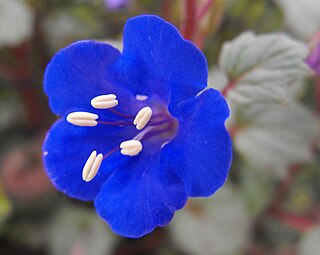
Phacelia campanularia is a species of flowering plant in the borage family, Boraginaceae, known by the common names desertbells, desert bluebells, California-bluebell, desert scorpionweed, and desert Canterbury bells. Its true native range is within the borders of California, in the Mojave and Sonoran Deserts, but it is commonly cultivated as an ornamental plant and it can be found growing elsewhere as an introduced species.

Ambrosia trifida, the giant ragweed, is a species of flowering plant in the family Asteraceae. It is native to North America, where it is widespread in Canada, the United States, and northern Mexico.

Dioscorea trifida is a species of flowering plant in the family Dioscoreaceae. It is a species of yam. It is native to the Caribbean and Central and South America. Its many common names include Indian yam, cush-cush, and yampee. It is called mapuey in Venezuela, inhame in Brazil, tabena and ñame in Colombia, sacha papa in Peru, and ñampi in Costa Rica.
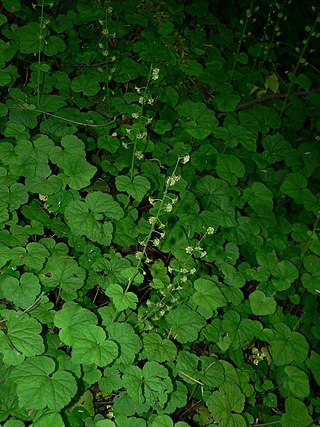
Mitella is a genus of flowering plants known as miterworts or bishop's caps. Mitella species are native to temperate and arctic North America and Asia.

Erysimum cheiri, syn. Cheiranthus cheiri, the wallflower, is a species of flowering plant in the family Brassicaceae (Cruciferae), native to Greece, but widespread as an introduced species elsewhere. It is also treated as a hybrid under the name Erysimum × cheiri. It is widely cultivated as a garden plant.

Gilia brecciarum is an annual flowering plant in the phlox family (Polemoniaceae), known by the common name Nevada gilia or break gilia.
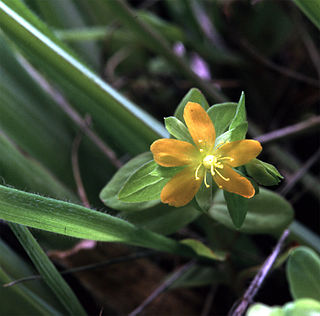
Hypericum anagalloides is a species of flowering plant in the St. John's wort family Hypericaceae. It is known by the common names creeping St. John's-wort, tinker's penny and bog St. John's-wort.

Ipomopsis congesta is a species of flowering plant in the phlox family, known by the common name ballhead ipomopsis. It is native to much of western North America, where it grows in many habitats from alpine peaks to low-elevation scrub. It is a perennial herb which varies in appearance, especially across subspecies and climates. It may take the form of a squat patch with stems under 10 centimeters in height or a more erect form up to 30 centimeters tall. The stems are often hairy to woolly. The thick leaves are usually fork-shaped with a number of clawlike lobes and 1 to 4 centimeters long. The flowers appear in a rounded, dense cluster atop the stem. Each flower is bell-shaped to funnel-shaped and white with a pale yellow throat and protruding yellow or white stamens. There are several subspecies, many of which were formerly considered species of Gilia.
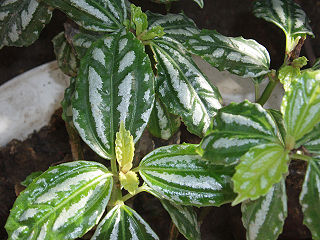
Pilea cadierei is a species of flowering plant in the nettle family Urticaceae. The species is endemic to the southern Chinese provinces of Guizhou and Yunnan, as well as Vietnam. The specific epithet cadierei refers to the 20th-century botanist R.P. Cadière. P. cadierei has earned the Royal Horticultural Society's Award of Garden Merit for its hardiness and reliability as a houseplant. In warmer countries, usually within USDA zones 8-12, the plant may be grown outside year-round as a perennial, either in-ground or contained, and pruned about 50% during the autumn.

Malva multiflora is a species of flowering plant in the mallow family known by the common names Cornish mallow and Cretan hollyhock. It is native to western Europe, North Africa, and the Mediterranean Basin, and it is naturalized in areas with a Mediterranean climate, such as parts of Australia, South Africa, and California. This is an annual or biennial herb growing a tough, somewhat hairy stem to a maximum height between 1 and 3 meters. The leaves are multilobed with flat or wavy edges, slightly hairy, and up to 10 centimeters long. The plant bears small pink or light purple flowers with petals just over a centimeter long. The fruit is disc-shaped with 7 to 10 segments.

Calyptridium monospermum, synonym Cistanthe monosperma, is a perennial plant in the miner's lettuce family (Montiaceae), known by the common name one-seeded pussypaws. It was formerly classified in the purslane family (Portulacaceae).

Coreopsis douglasii is a species of flowering plant in the family Asteraceae known by the common name Douglas' tickseed. It is native to California from Santa Clara County to San Diego County, as well as from Mohave County in Arizona.

Brewerimitella breweri is a species of flowering plant in the saxifrage family, known by the synonyms Mitella breweri and Pectiantia breweri and by the common names Brewer's mitrewort and Brewer's bishop's cap. It is native to western North America from British Columbia to central California and Nevada, where it grows in moist meadows, woods, and mountain forests.

Brewerimitella ovalis is a species of flowering plant in the saxifrage family known by the common names coastal miterwort and oval-leaf miterwort. It is native to western North America from southwestern British Columbia, including Vancouver Island, to northern California as far south as Marin County. It grows in moist, shady habitat, such as coastal forests and streambanks.

Pectiantia pentandra is a species of flowering plant in the Saxifrage Family (Saxifragaceae), known by the common names fivestamen miterwort or five-point bishop's cap.
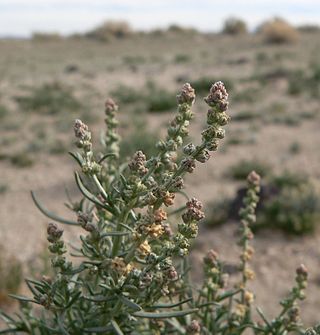
Oligomeris linifolia is a species of flowering plant in the small family Resedaceae known by the common name lineleaf whitepuff. It is native to parts of the Middle East and the Indian subcontinent, as well as southern Europe and North Africa, and the southwestern United States and northern Mexico. It grows in many types of habitat, including disturbed areas and saline soils, in deserts, plains, coastline, and other places. It is a fleshy annual plant, producing several erect, ribbed stems 35 to 45 centimeters in maximum height.
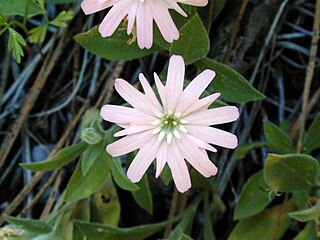
Silene hookeri is a species of flowering plant in the family Caryophyllaceae known by the common names Hooker's silene, Hooker's catchfly, Hooker's Indian pink, and Hooker's glandular campion.
Streptanthus fenestratus is an uncommon species of flowering plant in the mustard family known by the common name Tehipite Valley jewelflower.
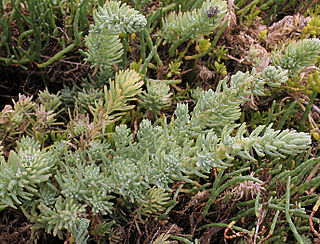
Suaeda taxifolia is a species of flowering plant in the family Amaranthaceae known by the common name woolly seablite.
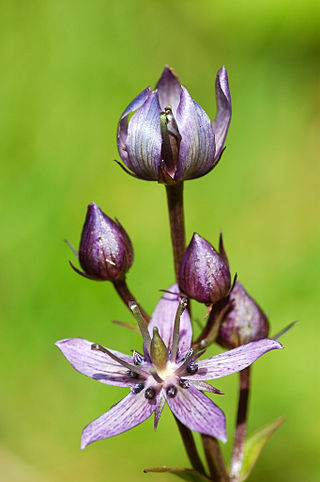
Swertia perennis is a species of flowering plant in the gentian family known by the common names felwort and star swertia. It is native to several regions of the northern hemisphere, including much of Eurasia and western North America. It is a plant of wetlands, particularly calcareous fens. It is common to abundant in many areas, but it is known to be negatively impacted by habitat fragmentation and other habitat destruction, and human activity has led to its extirpation from some areas where it was once common. It is a perennial herb producing usually one erect stem growing 10 to 50 centimeters tall. The basal leaves are spoon-shaped with rounded tips, and leaves higher on the plant are widely lance-shaped or somewhat oval, with pointed tips. The inflorescence is an open panicle of flowers atop the stem. Each flower has a calyx of four or five pointed sepals and a corolla of four or five pointed lobes each up to 1.3 centimeters long. The corolla is dull blue to violet in color with darker purplish veining or stippling. There are two rounded nectary pits at the base of each lobe of the corolla. Stamens tipped with large anthers surround a central ovary.



















